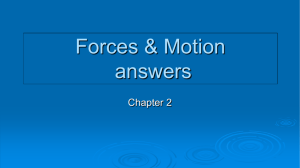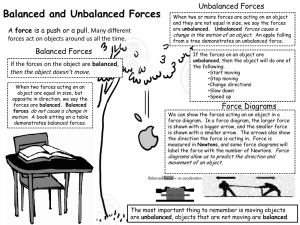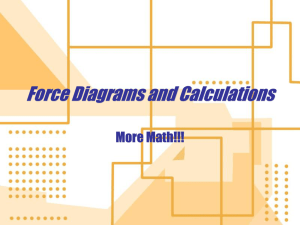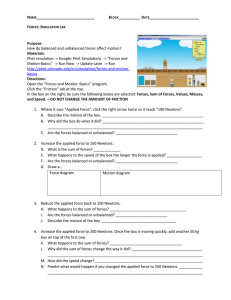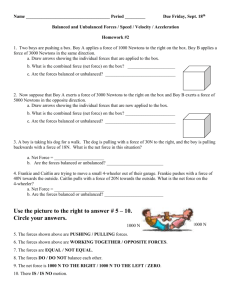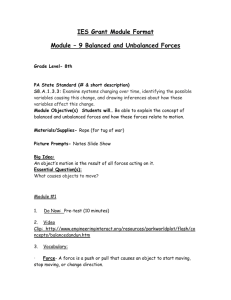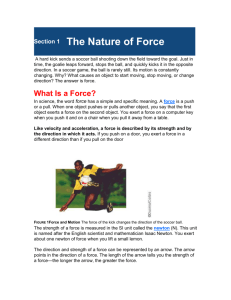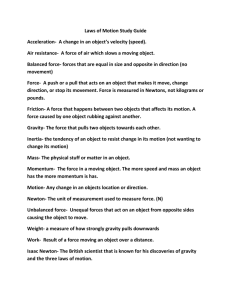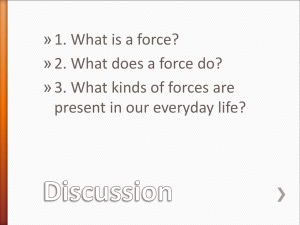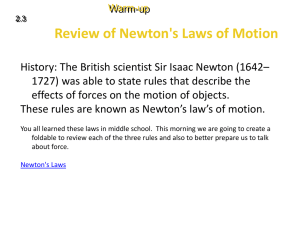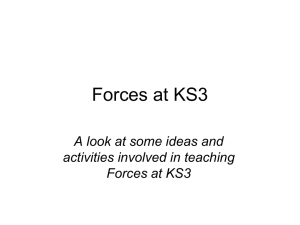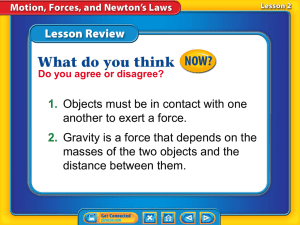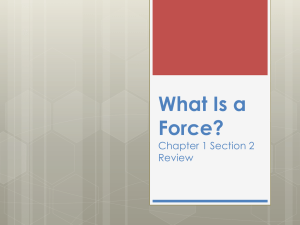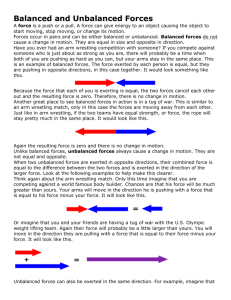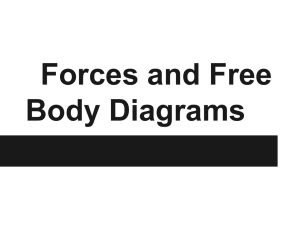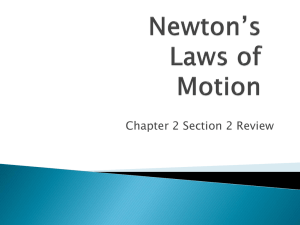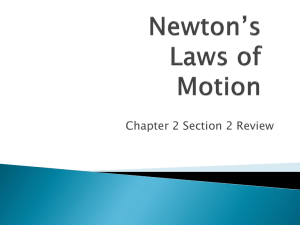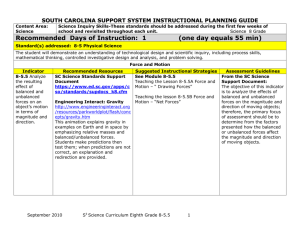FORCES - ed585kdavis
advertisement
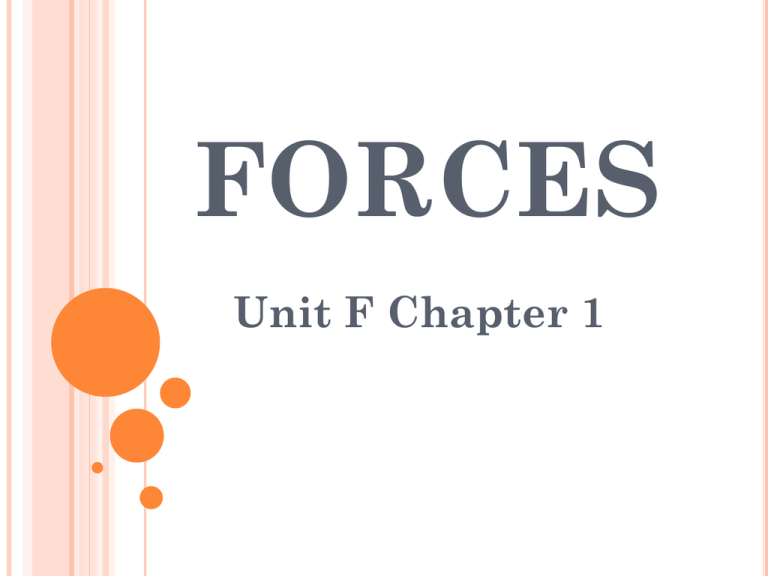
FORCES Unit F Chapter 1 CH 1 LESSON 1 INVESTIGATION Directions 1. Make a chart with three columns labeled: Object, Prediction, Result. 2. From your group of objects predict what objects will be attracted by the magnet. INVESTIGATION CONT… 3) Test each object and record whether or not the object is attracted to the magnet or not. 4. Bar magnets have a North and South poles. Bring the north-seeking pole toward a southseeking pole…what happens? 5. Now bring two south seek poles together and two northseeking poles…what happens? CH 1 LESSON 1 EVERYDAY FORCES What is a force? Any push or pull that causes an object to move, stop, or change speed and direction. An object ONLY moves, stops, or changes speed or direction when a force acts on it. What are 3 everyday forces? 1. 2. 3. Friction Magnetism Gravitation FRICTION Friction is a force that opposes, or acts against, motion when two surfaces rub together. When you go sleigh riding you keep moving on the snow because there is little friction between the snow and the sled. MAGNETISM Magnetism is the force of attraction between magnets and magnetic objects. Every magnet has a north and southseeking pole. Like poles repel. Unlike poles attract. Earth is surrounded by a magnetic field. GRAVITATION Gravitation is the force that pulls all objects in the universe toward another. The strength of gravitation between two object depends on the distance between them. Earth’s gravity keeps the moon in orbit. Remember: Force of gravity pulls on both objects. For example: If you throw a ball in the air, Gravity pulls the ball toward Earth. Gravity also pulls Earth toward the ball. Earth has more mass than the ball so the smaller object does most of the moving REVIEW QUESTIONS 1. 2. 3. 4. 5. What starts an object moving or stops it if it is already moving? Name three everyday forces. What force keep the moon in orbit around Earth? Suppose you push a cart toward the west. In what direction does the force of friction push on the cart’s wheels? The force of gravitation is less when – a. b. c. d. The total of the masses is greater Friction between them is greater The force of magnetism is greater The distance between them is greater CH 1 LESSON 2 FORCES THAT ACT TOGETHER Balanced Forces Are equal in size and opposite in direction. They cancel each other out. When forces are balanced an object’s motion or direction will not change. Because forces are balanced it seems as if no force is acting on the object at all. Unbalanced Forces Occur when one force is greater than its opposite force. When unbalanced force’s act on an object, the object can; start to move, speedup, slow down, stop or change direction. . EXAMPLE OF UNBALANCED FORCES When a football player is tackled, forces are unbalanced. When one player applies more force than another, the opposing player is stopped. ACTING IN PAIRS Forces ALWAYS act in pairs. When you walk your feet are pushing against the floor, but the floor is also pushing against your feet. NET FORCE We already know when two forces act on an object they will be balanced or unbalanced. The net force is adding or subtracting individual forces to find the value of the combined forces. If forces are opposite you subtract the smaller force. If forces are in the same direction you add the forces 1. Example: You TRY to push Ms. Davis over with a force of 130N. Ms. Davis is soooo strong she pushes back with the force of 300N. What is the net force? 300N – 130N = 170N REVIEW QUESTIONS 1. 2. 3. 4. 5. What happens to an object when balanced forces act on it? A moving object speeds up. Are the forces acting on the object balanced? EXPLAIN. Suppose you ride a bike along a flat, straight road at a constant speed. Are the forces acting on the bike balanced or unbalanced? Two bumper cars collide. Both cars stop. How do you know that a force has acted on both cars? Suppose a book weighs 35 newtons and you apply a force of 50 newtons to lift it. The net force acting on the book is? Which direction? ANSWERS 1. 2. 3. 4. 5. It seems as if no force is acting on the object. No, because the object’s speed increase so and unbalanced force is acting on it. Balanced, there is no change in motion or direction. The bumpers cars both stopped, therefore a force had to act on it. 15 netwons, Up CH 1 LESSON 3 INVESTIGATION Create this chart below in EXCEL: Column A Column B Column C Column D Weight Trial (Newtons) Height (meters) Work (Joules) Example: 30N 1 2 3 4 2M 30N x 2m = 60J DIRECTIONS 1. 2. 3. 4. 5. Weigh the notebook on the table using the spring scale and record its weight in Newtons under Trail 1 on the table. Measure the total height of the stairs in meters and record the measurement under Height in Trail 2. . Work can than be calculated by multiplying the weight x height = work. This can be done by using the “Math Function” in Excel. (Demonstrate) Suppose in Trail 2, you now carry your object 2 flights of stairs. Calculate your new height, and amount of work done. Continue this process up to Trail 4, continuing to increase the flights of stairs. DRAW CONCLUSIONS 1. Compare the amount of work a person carrying one notebook, one flight of stairs does, to a person who has to walk three flights of stairs. 2. Based on your data, interpret and draw conclusions about how much work is related to force and distance. QUESTION OF THE DAY: YOU STUDY FOR YOUR NEXT SCIENCE TEST FOR 3 LONG HOURS. HOW MUCH WORK HAVE YOU DONE?! ANSWER: NONE!!! So why have you not done any work? The scientific definition of work – is the use of a force to move an object through a distance. So unless you were walking and studying at the same time, you haven’t done work. How we calculate work. Weight x Distance = Work 1. Example: If you move a 2000N piano, 8m, how much work have you done. 2000N x 8m = 16,000J POWER Power – is the amount of work done for each unit of time. AKA: how quickly you complete work. The metric unit of power is the watt. Formula for power: Work ÷ time = Power SIMPLE MACHINES A machine is something that makes a task easier by changing the size or direction of the force, or distance over which the force acts. 6 types of simple machines. 1. 2. 3. 4. 5. 6. Pulley Wheel & Axle Wedge Inclined plane Screw Lever EVERYDAY MACHINES Compound machine is made up of two or more simple machines. A pencil sharpener is a good example. It combines wheel and axel to turn the sharpener, and a set of wedges to sharpen. NOT SO SIMPLE MACHINES http://player.discoveryeducation.com/index.cfm?g uidAssetId=604C7FB7-422E-4340-8215C5E7D77BDABB&blnFromSearch=1&productco de=DSC REVIEW QUESTIONS 1. 2. 3. 4. 5. How much work is done if you life a 20-newton weight 10 meters? Which involves speed-work or power? Look at the table of Pg. F18. How much power is needed to life 1 piano 1 floor in 10 seconds? Explain how a set of pulleys could help the gardener mentioned on page F18 remove the tree stump. The amount of power needed to do 10joules of work in 1 second is? a.) 1 watt b.) 10 joules c.) 10 watts d.) 1,000 watts WEB ACTIVITY: SIMPLE MACHINES http://www.edheads.org/activities/simplemachines/ Identify the different simple machines and their functions in a variety of locations with this interactive website.
